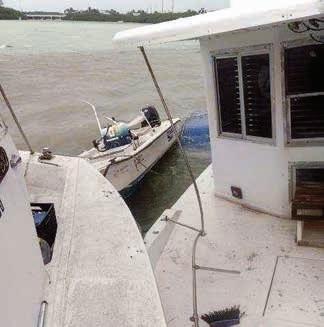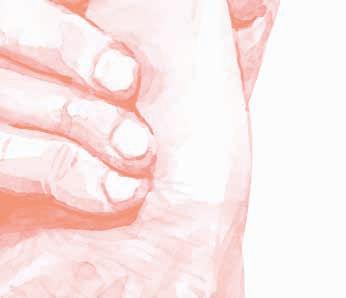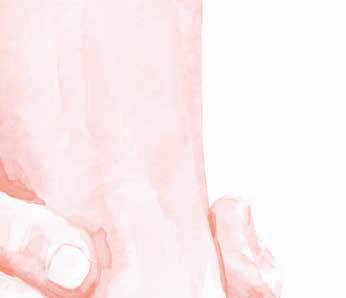
2 minute read
A HELPING HAND WHEN IT'S NEEDED MOST Keys Community Comes Together During Times
When Hurricane Ian struck Key West with strong winds, high surf and flooding, 45-year-old Carla Sanbe was on the hook, anchored aboard a 46-foot rented houseboat near Cow Key that she shared with her then-fiancé.

"My ex looked at me and said 'put on a life jacket,’ and I said ‘why, we're not going to survive out here,'” recalled Sanbe of the horrifying experience in September 2022. Sanbe, her fiancé and her dog did survive Mother Nature's wrath, but their houseboat did not. It ended up sinking, along with almost everything the couple owned.
of Disaster
"We lost most of our stuff," said Sanbe as she choked back tears. "We didn't even have shoes, we had no place to go."
Sanbe eventually left the fiancé and found another boat to live on, but her struggle was far from over. She had lost her dinghy motor during Ian, making it almost impossible for the mother of two grown sons to get to her waitressing job at Denny's.
"I was having a very hard time getting back and forth from work," explained Sanbe. She said without the dinghy, she was forced to kayak to shore, and some days that was just not possible.
This is where the Monroe County Community Organizations Active in Disasters (COAD) came into the picture and changed Sanbe's life. Loretta Geotis of the Salvation Army is on the board of COAD and was able to secure a dinghy motor for the stranded live-aboard. Sanbe was grateful.
"Just the peace of mind that I now have, knowing I can get back and forth to work if it's stormy or raining," said Sanbe. "I don't have to worry about kayaking in and out."
So exactly what is COAD and how does it work? For that answer, we spoke with Leah Stockton, Keys Area President with United Way of Collier and the Keys. She is an advisor for the nonprofit safety net that swoops into action immediately following a disaster, such as a hurricane.
"The point is a coordinated, collaborative effort to respond to whatever the disaster may be in our community," explained Stockton.
"We're all local, so we're most immediate," added Geotis.
What began as the keyswide long-term recovery group after Hurricane Irma in 2017 grew into the nonprofit Monroe County COAD in August 2022, one month before Ian hit.
"A COAD is the next step up from a long-term recovery group," explained Geotis.




There are currently more than 40 member organizations from Key West to North Key Largo collaborating to help residents immediately after a disaster. The membership is made up of faith-based groups, nonprofits, civic organizations and government agencies including Monroe County Emergency Management.
In the aftermath of Hurricane Ian, COAD was a game changer.
"We were there and we were boots on the ground before anyone else," said Geotis.
"We identified about 350 households that had Ian damage of some level and then that sort of became our marching orders for the COAD, that we now knew exactly who it was that we were helping," added Stockton.
To this day, the COAD case management team meets once a week and goes down the list of those still in need post Ian to ensure their needs are being met. This is a 100% nonprofit organization; everyone who contributes is a volunteer.
The Keys program has proven to be effective. Recently, Stockton was asked by FEMA to speak about COAD to organizations in California assisting residents with flooding.
“It's because our small close community works well together that we are able to so successfully help so many people in the event of an emergency," said Stockton.






